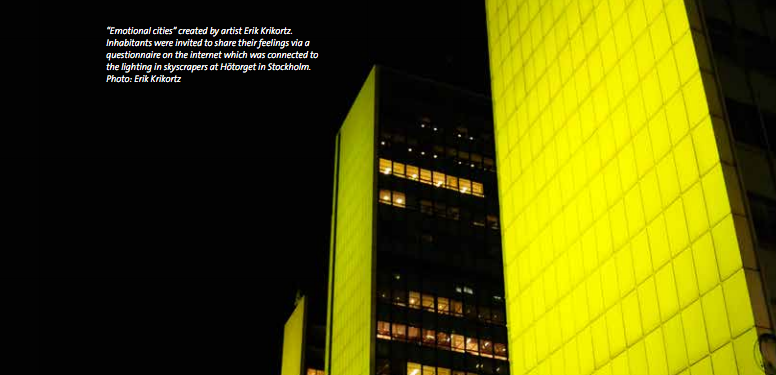Place Branding – expressing the unique

An article from Fagerhult’s Magazine The Innovator, november 2014
Text: Amelie Bergman
Place Branding is the new way for cities and regions to succeed in the global competition. A strong brand attracts new talents, businesses and investments. And even the most boring place in the world has its advantages, says place branding-expert Helena Nordström.
The concept of destination marketing has been around for a while. Launched by marketing guru Philip Kotler, it rose to prominence during the 2000s, with regions, cities and communities investing heavily in their brands.
Driven by increased globalization and urbanization, each place has to compete for its residents, jobs, investments and visitors.

– It’s important to realize that place branding is not solely about tourism. It’s about recruiting new talents and creating a dynamic environment. In place branding you consider the big picture in order to form an attractive community where people want to live, work and develop. Contemporary destination marketing is often managed in cooperation between public interests, companies and the inhabitants, Helena Nordström explains.
She is one of Sweden’s leading authorities in the field, founder and leader of consultant agency Placebrander. Customers include a wide range of Swedish and Finnish cities and organizations. Helena is also the founder of Placebrander’s Day and the Placebrander of the Year Award.
Everyone’s unique
As the different target groups are becoming more discerning, you have to distinguish yourself from the crowd. Finding your own niche is one way of staying competitive.
-Uniqueness is the key to successful place branding. Åre, a ski resort in northern Sweden, is an excellent example of this. The town has 3 000 inhabitants, but during the winter season it expands with 350 000 tourists. Rather than pigeonholing itself solely as a winter destination, they have looked beyond the poles, boots and snow. From bike parks and kayaking to fishing and saunas the resort has re-branded itself as a year round entertainment hub.
Another example mentioned by Helena is the petite Spanish village Miravete de la Sierra that’s marketing itself as “The Place Where Nothing Happens”. The campaign went viral and was a BIG success despite scarcely having the resources to accommodate any tourists.
-In a world where you are always connected and available, the thought of a place where nothing ever happens is very appealing to a lot of people.
Interactive Lighting Solutions
When used in unexpected and non-traditional ways, light can be a very effective tool for place branding. However, a simple focus on aesthetics isn’t enough to get social media buzzing.
-Interactive lighting solutions have the potential to get people’s attention. The trick is to make the spectator involved. A classic example of which was the interactive artwork “Emotional cities” created by artist Erik Krikortz. Inhabitants were invited to share their feelings via a questionnaire on the internet which was connected to the lighting in skyscrapers at Hötorget in Stockholm. If people where happy, the skyscrapers were swept into a warm, red light. If they felt blue…

-One other project I find fascinating is ‘Another Light Up’ in Monwasabi Park – one of Cape Town’s more dangerous neighbourhoods. The project leverages street art with the capacity of crowdfunded community engagement as a means for people to make a difference in their community. The ambition is to raise the money to light up one of the pathways in the area, and the residents can follow the development with the help of a multi-storey artwork which lights up every time enough money is raised for one new light to be installed on a pathway.
The ever-innovative Dutch have also proven to be adept place branders, investigating the connection between light, safety, traffic and energy efficiency.
-As part of the project ‘Smart Highway’ the motorway streetlights outside the city of Oss were replaced with light absorbing road markings. Charged by natural light, the proto-luminescent paint strips emit light, glowing in the dark.
It has to be real!
Inspiring lighting, breath-taking nature or a spectacular building (like the Ice Hotel in Swedish Jukkasjärvi) are all effective ways to draw attention to a place. But are there any other key factors for success?
-Authenticity! As always, when building a brand, you cannot make things up. It has to be real, otherwise people will turn their backs on you.
-And since it is all about holistic thinking, co-operation is essential. Create a neutral platform that unites the different stakeholders, rather an any individual group, such as the community, driving the project.
Another aspect which may require sacrificing is absolute justice whereby a smaller community may have to step back for the greater good of a larger region or metropolitan area.
-In my opinion, Amsterdam is one of the most successful place branders in the world. They’ve set a rather strict agenda; smaller communities and connecting regions have to market themselves as a part of the Amsterdam brand. I bet it’s not popular with everyone but it’s very effective. And, of course, it acts to serve the smaller places outside the city well to be associated with a powerful brand.
Most important of all: “Be creative. Be innovative. Every place has its own unique assets to communicate. No one’s impressed by a copycat.”
4 Place Branding Trendsetters According to Helena
The Modern Ambassador
Inhabitants who love their place on earth and spread the message digitally by Instagram, Twitter and Facebook are invaluable.
The Digital Enthusiast
Every community have their enthusiasts, working alone or together, often on a non-profit basis. The digital enthusiast is using blogs, films and websites to draw attention to a place or an event.
The Doer
This is the citizen who really wants to make a difference, with actions instead of words. “Hackatons” and “Maker Events” are often the result of the doer’s ventures.
The Global Consumer
People are becoming global – as consumers, as inhabitants and as tourists. And wherever we go, we want to feel welcome. This meaning higher demands on communication – for example language skills and wifi-accessibility – even in the small town.
